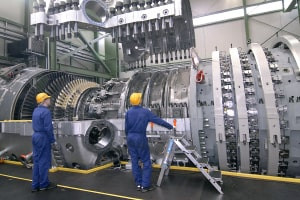This free online course covers the intricacies and mechanics of gas turbines and focuses on their marine application. We begin by introducing you to the functions of the components of a gas turbine: the compressor, combustion chamber and turbine. We then discuss the basics of gas turbine propulsion control systems, their advantages and disadvantages and how they are used to propel ships. We analyze the use of gas turbines in merchant marine vessels such as cruise ships, ferries, freight carriers, liquified natural gas carriers and container ships. The course establishes the merits of using gas turbine propulsion plants in commercial tonnage, the technical functions of combined-cycle gas and steam turbine electric (COGES) and the different COGES propulsion-system layouts. We also investigate the current trends in the use of gas turbines in the broader marine industry.
The course then lays out the three primary gas laws and principles that govern gas turbine operation: Bernoulli’s principle, Boyle’s law and Charles’ law, before examining the stages of the convergent-divergent process. We break down the complexities of adiabatic compression, ambient temperature and the importance of compressor cleanliness. We then cover the various cycles used in gas turbines: the Brayton cycle, intercooled cycle, intercooled recuperated cycle, reheat cycle, intercooled reheat cycle and the combined cycle. The course also identifies the different types, working systems and functions of gas turbine configurations, which include single-shaft, split-shaft and twin-spool engines. We establish the necessity of a power turbine for propulsion and describe the single shaft, twin shaft and concentric shaft power turbine. The course then delves into the foundation, enclosure, piping, fuel, lubrication, cooling as well as safety, control, monitoring and alarm systems of gas turbines of various classifications. We then lay out the three main sections of a gas turbine: compressor, combustor and the turbine. This includes explaining the phrases and terms associated with engine inspection and the materials used in the construction of gas turbines, which include special steels, titanium alloys and superalloys. We analyze in detail the working principles, components and types of axial flow and centrifugal compressor to make clear gas turbine coating protection.
This in-depth free online course suits anyone working in marine engineering and will greatly improve your working practical knowledge of the principles that guide the construction and use of gas turbines.
What You Will Learn In This Free Course
View All Learning Outcomes View Less All Alison courses are free to enrol, study, and complete. To successfully complete this Certificate course and become an Alison Graduate, you need to achieve 80% or higher in each course assessment.
Once you have completed this Certificate course, you have the option to acquire an official Certificate, which is a great way to share your achievement with the world.
Your Alison certificate is:
- Ideal for sharing with potential employers.
- Great for your CV, professional social media profiles, and job applications.
- An indication of your commitment to continuously learn, upskill, and achieve high results.
- An incentive for you to continue empowering yourself through lifelong learning.
Alison offers 2 types of Certificate for completed Certificate courses:
- Digital Certificate: a downloadable Certificate in PDF format immediately available to you when you complete your purchase.
- Physical Certificate: a physical version of your officially branded and security-marked Certificate
All Certificate are available to purchase through the Alison Shop. For more information on purchasing Alison Certificate, please visit our FAQs. If you decide not to purchase your Alison Certificate, you can still demonstrate your achievement by sharing your Learner Record or Learner Achievement Verification, both of which are accessible from your Account Settings.











 Avg. Hours
Avg. Hours  Contains Video
Contains Video  CPD Accredited
CPD Accredited 
 Total XP:
Total XP: 
 Knowledge & Skills You Will Learn
Knowledge & Skills You Will Learn 







